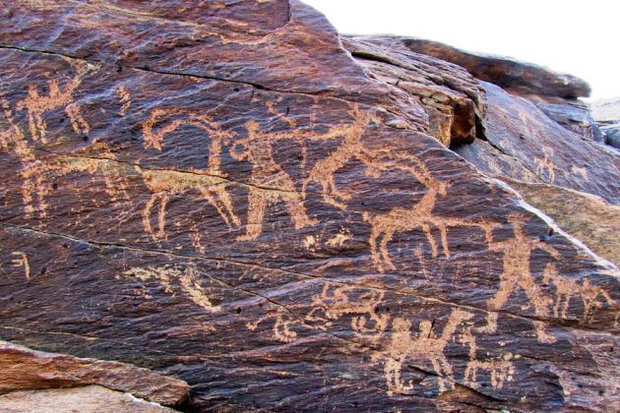Mining operations brought to halt near millennia-old petroglyph site

TEHRAN – Mining operations have recently been brought to a halt near Teymareh due to help protect millennia-old petroglyphs, which are scattered across the archaeological site in the Zagros mountain range, central Iran.
“A ban has been enforced on mining activities in the neighboring lands of Teymareh petroglyph site [which is located in Khomein, Markazi province]…. And the legal bar was reached through the efforts of the provincial directorate of the cultural heritage, tourism, and handicrafts,” Khomein’s tourism chief Ali Mashhadi announced on Wednesday.
“We will not allow any mine to operate in the registered and historical areas," he said.
Teymareh is home to numerous petroglyphs estimated to be carved in a period spanning from 40,000 to 4,000 years ago."Violators will be dealt with by the judicial system,” the official noted.
The official said that the boundaries and properties of the Teymareh site, which have been registered in its regions of Dash-Darreh and Tangeh-Gharqab so far, spans over 1700 hectares.
Earlier this year, Mashhadi announced that Iran seeks a possible UNESCO tag for Teymareh petroglyphs, adding “Similar petroglyphs, which have been discovered in the provinces of Isfahan and Lorestan, can be included in the dossier for a collective registration.”
Teymareh is home to numerous petroglyphs estimated to be carved in a period spanning from 40,000 to 4,000 years ago, providing insights into past eras and cultures both by tools utilized for carving and themes being carved.
Last year, a prehistorical petroglyph, which bears Pahlavi script written by ordinary people of the time, was found during an archaeological survey in the Teymareh region of central Iran. “This is the sixth petroglyph, engraved with Pahlavi script, which has so far been found in the highlands of Teymareh. And the petroglyph is estimated to date back to 2,200 years ago,” according to Iranian archaeologist Mohammad Nasserifard.
In March 2020, a team of entomologists and archaeologists concluded that a previously-founded petroglyph showcases a six-limbed creature with the head and arms of a praying mantis. The rare 14-centimeter rock carving was first spotted in the Teymareh rock art site during surveys between 2017 and 2018, but could not be identified due to its unusual shape.
International experts Jan Brouwer and Gus van Veen have examined the Teymareh site estimating its carvings were made 40,000-4,000 years ago. Prehistoric rock art provides insights into past eras and cultures as archaeologists classify the tools for the carvings by specific eras Incising tools include flint, metal, or thigh bones of hunted prey.
A 2019 study published in the Journal of Human Evolution, suggests that Neanderthals were roaming over the Iranian Zagros mountain range sometimes between 40 to 70 thousand years ago.
Until the late 20th century, Neanderthals were regarded as genetically, morphologically, and behaviorally distinct from living humans. However, more recent discoveries about this well-preserved fossil Eurasian population have revealed an overlap between living and archaic humans.
Neanderthals lived before and during the last Ice Age of the Pleistocene in some of the most unforgiving environments ever inhabited by humans. They developed a successful culture, with a complex stone tool technology, that was based on hunting, with some scavenging and local plant collection. Their survival during tens of thousands of years of the last glaciation is a remarkable testament to human adaptation.
Zagros mountain range in southwestern Iran, extending northwest-southeast from the border areas of eastern Turkey and northern Iraq to the Strait of Hormuz, is about 990 miles (1,600 km) long and more than 150 miles (240 km) wide. It forms the extreme western boundary of the Iranian plateau, though its foothills to the north and west extend into adjacent countries.
According to Britannica, the oldest rocks in the Zagros range date to Precambrian time (that is, before 541 million years ago), and the Paleozoic Era rocks date to between 541 million and 252 million years ago are found at or near the highest peaks.
AFM
Leave a Comment